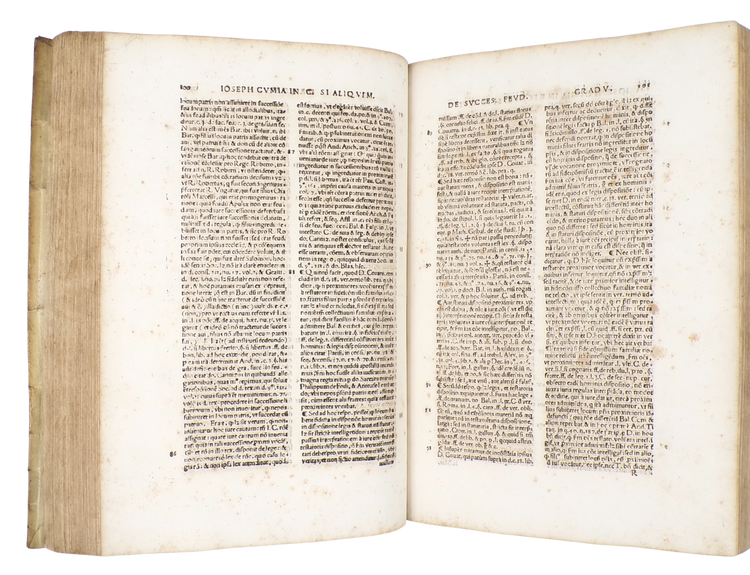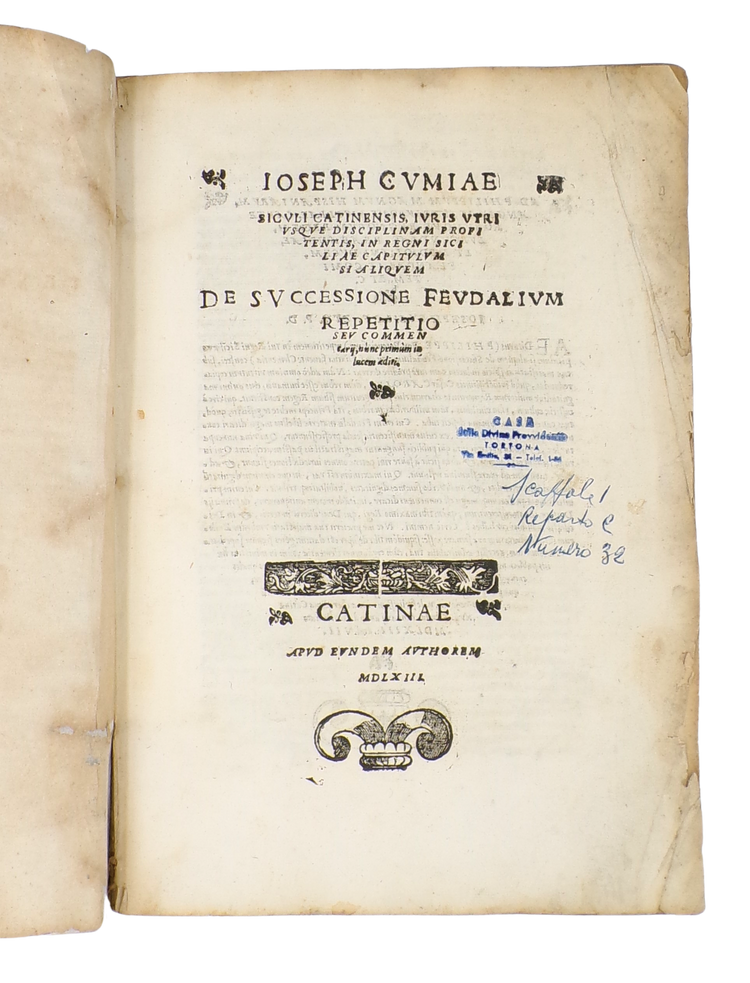Cumia, De successione feudalium, 1563.
- Regular price
- €8.500,00 EUR
- Regular price
-
- Sale price
- €8.500,00 EUR
- Unit price
- per
From the legendary first press in Catania, Sicily
Giuseppe Cumia (1531-1593).
De successione feudalium repetitio seu commentarij, nunc primum in lucem aediti.
Catania, apud eundem authorem, 1563 (colophon: Catinae, impressorum defectu idem author impressit,1563).
Folio in 6s. [4], 452 pp. Collation: [π]⁶A-2O⁶ = complete (matches copy Biblioteca Nazionale Centrale di Roma).
Contemporary limp vellum with ink title on spine.
First edition of Sicilian jurist Giuseppe Cumia's main legal work, printed by himself at his legendary press.
A recent study recorded only 17 copies of the 4 editions that were published from Cumia's press (see Aiello 2020).
There was no printing press in Catania until Cumia set one up in his house. He spent almost all of his life in Catania, first as a law student, then as a teacher and scholar of law. In 1562 he travelled to Messina to have a collection of his poetry published at the Spira printing house, but when the owner died Cumia arranged for the printing equipment to be installed in his house in Catania. In August 1562 he proceeded to print his poetry, titled Rime, with help of Petro Spira. But Spira almost immediately abandoned the job, forcing Cumia to continue the work himself. With support of his son Alessandro, a maid and a Moor and Ethiopian servants they managed to print books. In the final words of the Rime Cumia vividly narrates their method: “[Cumia] set the type, Allessandro sets the page, the maid inks and the Moor and Ethiopian pull!” The Rime was printed in February 1563 (1562 on title is an obvious fault).
A few months later he printed a second, improved, edition of the Rime, of which only one copy is recorded now. In the dedication of this second edition Cumia states that he is engaged in the completion of a legal work, which will be printed shortly: that would be De successione feudalium, the book we offer here. It was published in 1563 and in the preface of this legal work Cumia claims to have printed 1000 copies, though only 10 are recorded by Francesca Aiello in her 2020 bibliography of the Cumia press. Cumia claims to have completed the book after great efforts and periods of discouragement at the age of 32.
While the Rime counts only 68 pages in octavo, De Successione feudalium, covering inheritance and succession under feudal law, was more ambitious. It is printed in folio and counts 452 pages. It is seen as Cumia’s most important legal work (see Di Grazia) and after publication his career as a judicial scholar took off. He taught law continuously from 1565 to 1587 and was appointed judge of the Grand Court of the Kingdom of Sicily in 1577, in 1583 and once again in 1589.
The final book to be printed at his press was Practicasindicatus cum theorica in 1568, of which only a single copy is known to survive. Cumia abandoned the printing business by the 1570’s because by then he was a well-known author and in demand by publishers, making his press obsolete. The Spira heirs had decided to continue their father’s business in Messina and took back the equipment from Cumia. A second edition of De Successione feudalium appeared in 1609 at Panormi (Palermo) by Erasmum de Simeone. Catania remained without a press until 1623, when one was set up by Giovanni Rossi.
Condition: binding recently functionally repaired by Redbone Bindery. Original vellum of mediocre quality, soiled and slightly worn, pencil inscriptions on front cover, label on spine. Old owner's inscription in ink on back of front cover. Inscription and stamp on title-page. Inconsistent spotting, soiling and some old ink underlining throughout. Modern ink underlining at colophon. Otherwise contents in good condition.
Literature:
Fallico di Grazia, Dizionario Biografico degli Italiani. Volume 31 (1985).
G. Boemi, ‘Giuseppe Cumia e la prima stamperia in Catania (1562)’, in: Riv. dei Comune di Catania, III (1931), 4, pp. 17-23.
Francesca Aiello, ‘Giuseppe Cumia giurista e tipografo nella Catania del Cinquecento’, in: Tipografi, librai ed editori minori per la storia del libro (2020), pp. 29-44.
Provenance: Casa delle Divine Provvidenza, Tortona, Italy; 1990’s - private collection Mijdrecht, The Netherlands.

19th century depiction of Cumia at his press with his son, maid and servant
Couldn't load pickup availability
Share






Contact
Email: hugo@artemrarebooks.com
Phone: +31651042297
Visit us on appointment at:
Former US Embassy
Lange Voorhout 102
2514EJ
The Hague (The Netherlands)
Shipping address:
Nannie van Wehlstraat 51
2548MN
The Hague
The Netherlands






